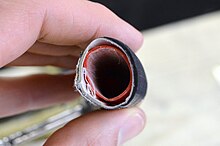

A tubular tyre, referred to as a tub in Britain,[1] a sew-up in the US, a single in Australia[citation needed], or just a tubular is a bicycle tyre that is stitched closed around the inner tube to form a torus. The combination is then glued (sometimes with two-sided tape) onto a specially designed rim, referred to as a "sprint rim" in Britain,[2][3] and just a "tubular rim" in the US,[4] of a bicycle wheel.
The combination of a tubular tyre and its tubular rim is lighter than that of a clincher tyre and clincher rim, and will therefore always result in less rotating mass or a stronger construction.[5] Tubulars can also be used over a wider range of tyre pressures from 1.7 to 14 bar (25 to 200 psi), compared to the typical 6-9 bar on a clincher tyre.
- ^ Sheldon Brown. "Sheldon Brown's Glossary Tp-Z: Tub". Retrieved 2016-09-28.
- ^ St. Pierre, Roger (1978). The Book of the Bicycle. Tribune Books Press. pp. 24–26. ISBN 0-85674-016-0.
- ^ Sheldon Brown. "Sheldon Brown's Bicycle Glossary Sp-Ss: Sprint". Retrieved 2010-03-22.
British: a rim designed for tubular tyres.
- ^ "Tubular Tire Gluing". Park Tools. Retrieved 2010-03-24.
The tubular is then glued to a special rim, called a tubular rim.
- ^ Arthur S. Waltho (1964). Guide to Tubular Tyres, Including Sprint Rims.